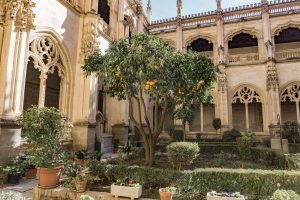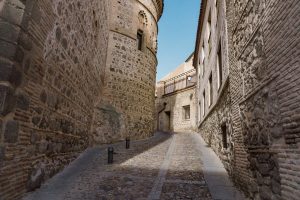If you’ve ever heard the expression “Holy Toledo!”, which means something is mind-blowing, it probably started with this beautiful town just an hour south of Madrid. Known as the “City of Three Cultures”, Toledo shows influences of Christian, Muslim, and Jewish culture. Toledo is filled with representations of these three cultures in the form of its architecture, art, and gastronomy.
I had heard that Toledo was a special place, but it blew my expectations out of the water from the moment we pulled up. We drove along a narrow road hugging the side of a rocky hill. Looking out the window we saw a city perched on a hill, surrounded by the river on three sides. Luckily, the bus stops at a lookout point on the highway so we were able to take pictures of the panoramic views of the city and surrounding landscape.

What we did
First up was a snack stop in Plaza Zocodover in the city center. Surrounding the square there are plenty of little bakeries and cafes to grab a quick bite to eat. Or, you know, there’s always a Mcdonald’s if you’re feeling like that kind of tourist – no judgements.
After refueling, we split off into groups for some sightseeing. If you’re an architecture or history buff, Toledo is the place for you. The churches, synagogues, and monasteries boast influences from each of the three cultures of Toledo.
My favorite site in Toledo was the Synagogue of Santa Maria la Blanca. Built in 1180, it’s the oldest synagogue building still standing in Europe. The interior of the building contains beautiful white arches and pillars with gold details, which shows evidence of the Muslim influence during that period. The Muslim influence is apparent in its white arches and pillars. The structure is considered to be a symbol of the cooperation of the three cultures during the Middle Ages.

Other impressive pieces of architecture located within the city are the Monastery of San Juan de los Reyes, completed in 1504, and the Iglesia de San Román, a 13th century example of Mudéjar architecture. San Román was my other favorite site. At the back of the church, there was a tiny spiral stairway that lead to the tower of the church with incredible views of the city.


What we ate

If you’re on a budget, there are lots of little stores to pick up cheap sandwiches or pastries. A coffee and pastry should set you back about €2.50, while a basic sandwich will cost under €3.
We opted for the budget bites, but if you’re in the mood to splurge, Toledo has some unique dining options. Voted Spain’s 2016 Capital of Gastronomy, regional dishes include a lot of game-meat stews and sheep’s milk cheeses. Try a bowl of Ciervo en Salsa (venision stew), Partridge stew, or Queso de Ovejar (aged sheep’s milk cheese) for an authentic taste of Toledo.
Toledo’s Quirks
Walking down the winding streets of Toledo, we found endless stores selling swords and marzipan.
According to some theories, marzipan was invented by the nuns of the Convent of San Clemente in Toledo. It’s said that during a period of famine, the nuns made a paste of almonds and sugar to feed to the undernourished people of the city after the Battle of las Navas de Tolosa. In some stores, we even found little nun figurines “making” the marzipan in the window.
Swords and other steel goods have been famous in Toledo since pre-Roman times. Nowadays, the swords are mostly used for decorations, and for the film industry. Toledo’s swords have been featured in numerous productions, the most famous being Lord of the Rings.
Bonus Activities

If the weather cooperates, you may be able to zipline past the San Martín bridge, one of the most visited monuments in town. Each jump costs €10 and you can buy your tickets directly at the Zipline booth. A few people in our group did this activity, but most of us enjoyed watching from the picturesque bridge instead.
If you have time, you can pay to enter the Toledo Cathedral. The admission price scared us off at €12.50 but it’s known as one of the most important cathedrals in Spain. We decided to wander the city a little more and find some snacks instead.
After learning about the “City of Three Cultures” in class, it was fascinating to walk through the streets myself and see the representations of the different cultures firsthand. Walking through the charming cobblestone streets and feeling the history in the elaborate churches and synagogues was an experience I’ll never forget.




Leah Eisenhauer is a current student on the Study Abroad Program in Spain.

